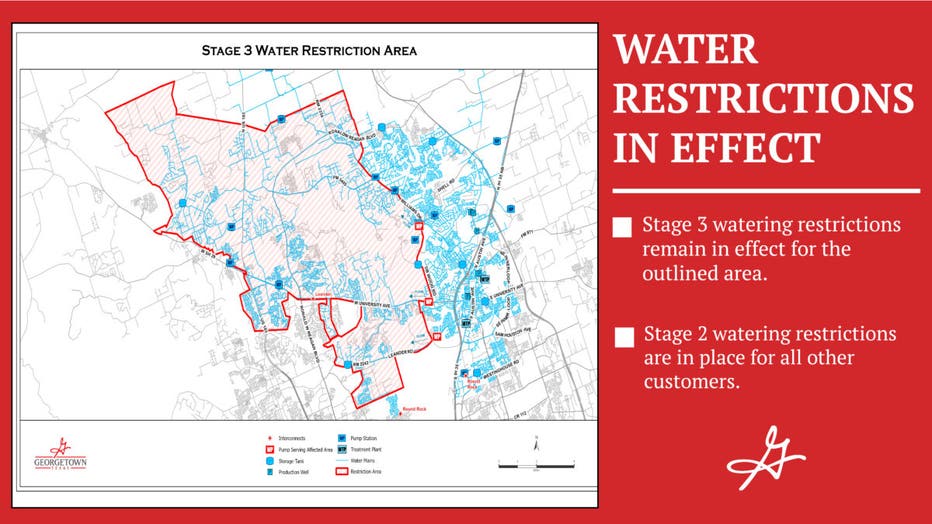Georgetown map shows Stage 2, Stage 3 water restrictions

Georgetown water restrictions continue
According to the Georgetown city manager, parts of the city are under a stage 2 water restriction, and another part is under stage 3.
GEORGETOWN, Texas - Water will continue to flow in Georgetown through the summer drought, according to city manager David Morgan.
"So our system is stable at this time. We do not anticipate that we will be moving into stricter, or additional stages. Our goal actually is to find ways to pull out of Stage 3 for the Western side of our Water," said Morgan.
David Morgan and Chelsea Solomon, who head up the water utility, say the city’s divisive water restriction order will remain in place for the next few weeks.
Part of Georgetown is in Stage 2. On a map provided by Georgetown utilities, the area inside a red boundary line with 23,000 customers, is in Stage 3. Supply and pumping capacity on the western side of town, which has higher elevations, cannot keep up with demand.

Georgetown water restrictions
"There is roughly a 100-yards differential between those two pressure plains, so pumps are designed to pump to each of those separately, so it is purely the one out west that is struggling right now," said Solomon.
Yards are turning brown under the heat, even though it’s estimated that 75% of the water used in Georgetown goes toward irrigation. Trying to get that under control is why city officials say about 150 citations are issued every day for violation of water restriction rules.
Ellen Klapper told FOX 7 she saw a spot where sprinklers were spraying down dirt.
RELATED COVERAGE:
- Several Central Texas cities announce water restrictions, boil water notices
- City of Georgetown extends Stage 3 of drought contingency plan for some residents
- Georgetown residents unable to cool off with water under Stage 3 restrictions
"And when I look at it, I wonder why is my daughter’s yard dying and why are they not protecting our drinking water," said Klapper.
A new water treatment plant at Lake Georgetown is being built, but it will not open until 2025. Two expansion projects, originally scheduled to be completed this month, are delayed due to supply and construction problems. One site may open in August which is a reason why city leaders say water restrictions may be scaled back in early September.
"Follow the rules, help us get things back online quicker," said Health Nuckolls, who lives in a Stage 3 neighborhood.

Georgetown enters Stage 3 water restrictions
Water is no longer an option to help cool off in Georgetown as the city bumped up its restrictions to Stage 3 Friday.
To meet future demand, city officials admit some extreme options may have to be considered.
"There are plans in the future to look at actually treating the water to where we can put it back into our drinking water supply," said Morgan.
Another long range idea is to build underground storage aquifers that can be used in times of need. Near term ideas include ramping up water conservation rebate programs.
Eventually, the current supply system, which includes eight wells, is expected to go from producing 45-million gallons of water a day, to 95-million gallons a day. Increasing the supply also includes additional water deals with nearby communities.
"We believe that will pull us out of the margin that we are in today," said Morgan.
For now, a water shortage is not in the forecast for Georgetown, but conservation and cooperation is still needed this summer.

